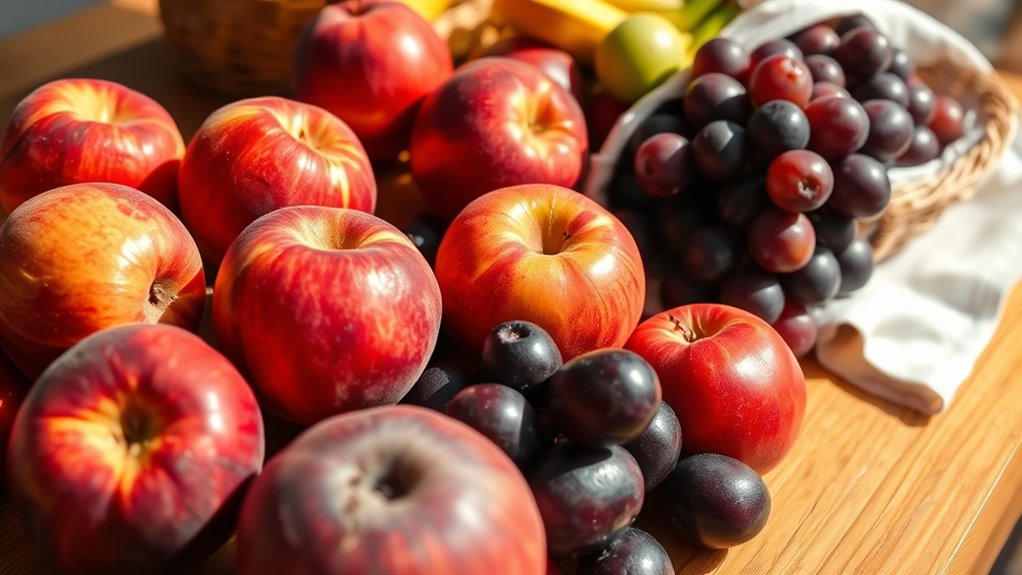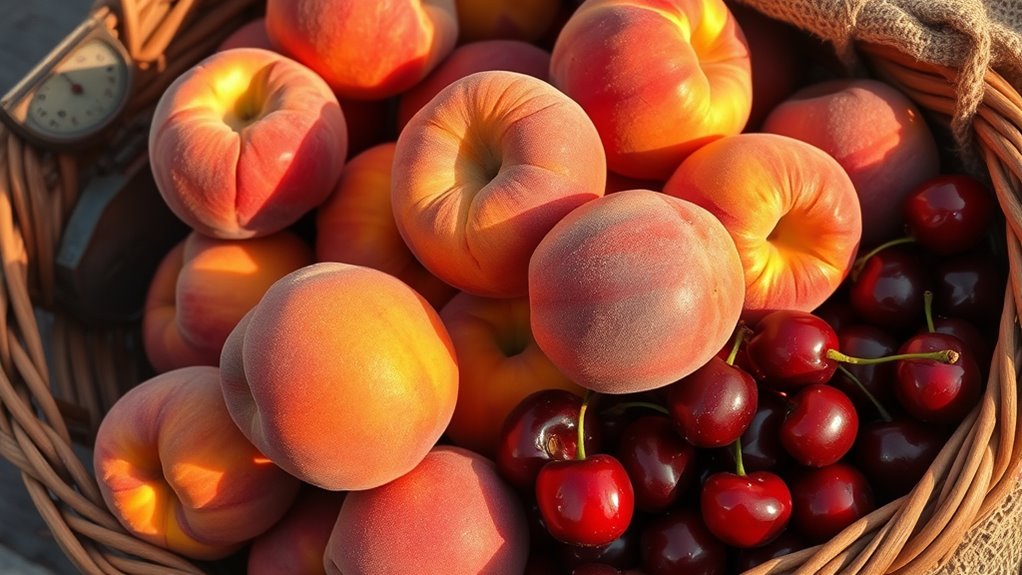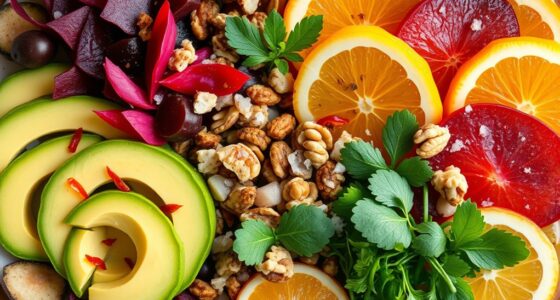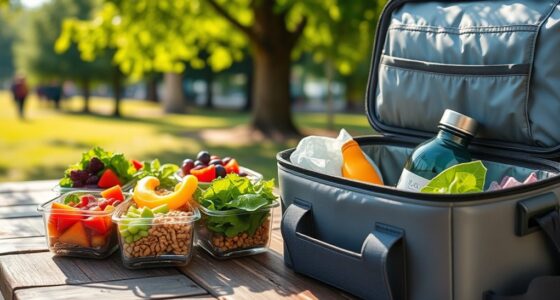To get the best flavor from your fruit, look for vibrant color, a fresh aroma, and a gentle firmness with slight give. Handle fruits carefully to prevent bruising, and ripen stone fruits at room temperature, using a paper bag to speed up the process if needed. Store berries and grapes in breathable containers in the fridge, and keep apples in the crisper. For more tips on perfecting your fruit game, keep exploring.
Key Takeaways
- Select fruit based on vibrant color, aroma, and slight firmness for optimal ripeness.
- Ripen fruits at room temperature, using paper bags to speed up ethylene gas accumulation.
- Check for signs of ripeness like aroma and gentle give; avoid overripe or underripe fruit.
- Store berries and grapes in breathable containers in the fridge, keeping them unwashed until use.
- Handle fruit gently to prevent bruising, and remove spoiled pieces promptly to maintain freshness.

Achieving the best flavor from your fruit begins with making the right choices at the store and knowing how to handle it afterward. When selecting fruit, look for signs of proper fruit ripening, such as vibrant color, firmness, and a fresh aroma. Gently squeeze the fruit to check for a slight give—if it’s too hard, it may not be ripe enough; if it’s too soft, it might be overripe. Trust your senses: the smell can often reveal whether the fruit is at its peak flavor. For example, ripe peaches emit a sweet, fragrant aroma, while ripe strawberries should smell fresh and sweet. Picking the right fruit at the right stage of ripeness ensures you enjoy maximum flavor and texture. Additionally, understanding natural ripening processes can help you better determine the perfect moment to enjoy your fruit for optimal taste.
Choose ripe fruit by color, aroma, and gentle firmness for maximum flavor.
Once you’ve chosen your fruit, understanding how to handle it and store it properly is vital. Proper fruit ripening is a delicate process; some fruits, like bananas and tomatoes, ripen best at room temperature. You can accelerate ripening by placing them in a paper bag, trapping ethylene gas that speeds up the process. Conversely, if the fruit is already ripe and you want to prolong its freshness, transfer it to the refrigerator. But remember, refrigeration isn’t suitable for all fruits—apples, berries, and grapes typically benefit from colder storage, which slows down ripening and preserves flavor.
Ideal storage conditions vary depending on the type of fruit. For most berries and grapes, keep them in their original containers or a breathable produce bag in the fridge. Avoid washing berries until you’re ready to eat them, as excess moisture can cause mold. Stone fruits like peaches, plums, and nectarines should be ripened at room temperature until they reach the desired softness, then refrigerated if not consumed immediately. Apples can be stored in the crisper drawer for several weeks, as they stay fresh longer when kept cool and slightly humid.
It’s also essential to handle fruit carefully to prevent bruising, which can accelerate spoilage and diminish flavor. Keep delicate fruits separate from heavier produce, and avoid stacking them too high. Regularly check stored fruit for signs of over-ripeness or spoilage, removing any damaged pieces to prevent affecting the rest. By paying attention to fruit ripening stages and maintaining ideal storage conditions, you maximize flavor, freshness, and enjoyment from your fruit. Remember, the key is to pick ripe fruit, handle it gently, and store it under the right conditions to savor peak flavor every time.
Frequently Asked Questions
How Do Different Climates Affect Fruit Ripening Times?
Different climates considerably influence fruit ripening times, affecting regional ripening patterns. In warmer climates, fruit ripens faster due to higher temperatures, so you might harvest earlier. Cooler climates slow down ripening, giving you a longer window for fruit development. Climate variability, such as unexpected cold snaps or heatwaves, can disrupt these patterns, so you should monitor local conditions closely. Adjust your harvest schedule accordingly to make certain fruit reaches peak flavor.
Can Artificial Ripening Methods Impact Fruit Flavor Negatively?
Artificial ripening can be like a false dawn, sometimes promising ripe fruit but delivering flavor degradation instead. You might notice that fruits treated this way lack the vibrant taste and aroma of naturally ripened ones. These methods often strip away complex flavors, leaving behind a bland, hollow experience. So, while they speed up ripening, they can rob your fruit of the depth and richness that make it truly delightful.
What Are the Best Containers for Storing Different Fruit Types?
You should use specific fruit storage containers to keep your fruit fresh longer. For berries, choose breathable containers like clamshells or vented plastic containers to prevent moisture buildup. Apples and pears store well in perforated or vented plastic bags, while citrus fruits stay fresh in mesh bags or ventilated containers. Superior fruit packaging minimizes bruising and preserves flavor, so select containers based on each fruit’s moisture and airflow needs to extend freshness.
How Can I Tell if Fruit Is Overripe or Just Ripe?
You’ll know fruit is overripe when its color shifts from vibrant to dull or faded, and it feels overly soft to the firmness test, almost like a gentle squeeze reveals a mushy texture. If it’s just ripe, it’ll have a rich hue and a slight give under your fingers, not a squishy mess. Trust your senses—color and firmness are your best guides to perfectly ripe fruit.
Are There Specific Storage Tips for Organic Versus Conventional Fruit?
You should store organic fruit carefully to maintain its freshness, often in the refrigerator’s crisper drawer, and avoid washing until just before eating. For conventional fruit, follow similar storage tips but be mindful of any specific guidelines on packaging. Organic fruit may need quicker consumption since it lacks preservatives, while conventional fruit benefits from controlled atmosphere storage. Always check for spoilage and handle both types gently to preserve flavor and quality.
Conclusion
By paying close attention to how you choose, ripen, and store your fruit, you open a world of vibrant flavors waiting to delight your senses. Think of each piece as a hidden treasure, revealing its true beauty only when handled with care. When you master these simple steps, you’re not just preserving freshness—you’re cultivating a symphony of taste that transforms everyday bites into extraordinary moments. After all, great flavor begins with mindful choices.










